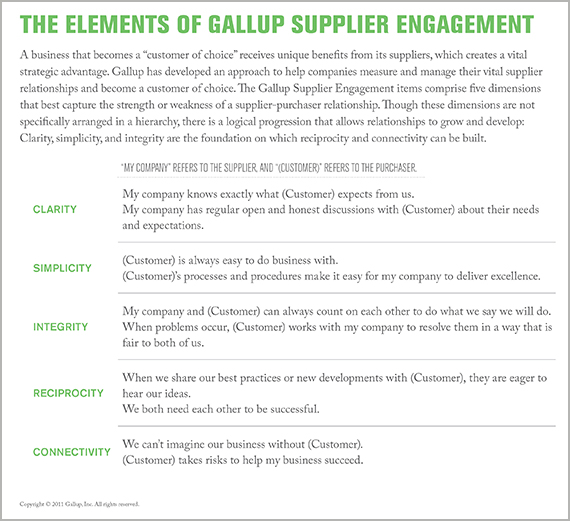Changes in the global economy have fundamentally reshaped the nature of supplier-customer relationships.
Companies that sell directly to consumers have been seeking greater insights into the emotional factors that create and cement customer relationships for more than a decade. By now, most of these companies know that strong, sustainable customer engagement is built on rational and emotional elements -- and that engaging customers returns tangible benefits.
Gallup's analysis shows that engagement is also important in supplier relationships, and the relationship is stronger and more meaningful than many companies realize. Suppliers will go above and beyond for one customer over another, yielding advantages for those who are considered a "customer of choice."
As we noted in our previous article on supplier engagement, a business that becomes a customer of choice receives valuable benefits from its suppliers: access to the supplier's best people, access to the resources required to serve account relationships, first access to innovation and the supplier's latest technological advances, more favorable terms, shared risk taking, and priority allocation of resources or production capacity in times of scarcity. Being a supplier's customer of choice can create a vital strategic advantage.
Assessing supplier engagement
Some companies have attempted to measure and manage their supplier relationships by using complex tools to explore every conceivable functional dimension of the customer-supplier partnership. However, there was no simple metric to help a company determine its levels of supplier engagement, nor was there a simple process to ensure ongoing and productive conversations between suppliers and purchasers to highlight opportunities for improving their relationship.
To rectify this, Gallup developed an approach to help companies measure and manage their vital supplier relationships and to help them become a customer of choice. In developing this approach, our goal was to identify a core set of conditions that measures a supplier's engagement level with a customer, then to compare and manage supplier relationships to obtain the desired outcomes without additional cost.
Gallup's research, in collaboration with Mars, Inc., involved interviewing a large sample of suppliers representing direct and indirect products and services. These businesses represented varied levels of purchasing importance and supply market complexity, enabling us to assess levels of engagement among suppliers within each quadrant, building on Peter Kraljic's supply matrix framework. Nearly 1,000 supplier representatives from more than 600 different companies took part in the initial interviews.
Based on the results of these interviews, Gallup selected 10 items with the strongest linkages to key outcomes -- such as a supplier's willingness to take risks for the client, a supplier's willingness to give clients priority and access to scarce resources, buyer-evaluated quality of the current relationship, and relationship momentum (improving or declining) -- to include in the final metric. These items comprise five core dimensions that best capture the strength or weakness of a buyer-supplier relationship.
Though these dimensions are not specifically arranged in a hierarchy, there is a logical progression that allows relationships to grow and develop. Clarity, simplicity, and integrity are the foundation on which reciprocity and connectivity can be built.

Prioritizing supplier engagement efforts
Though most companies would benefit from evaluating and nurturing all of their stakeholder relationships, not all those relationships are equally valuable or crucial to a business' health or survival. Each company must make informed choices about prioritizing its supplier relationships, focusing its greatest efforts on high-priority relationships that have the most potential to affect its future.
Applying a clear supplier segmentation strategy can help companies identify suppliers that are mission-critical from those that are not. A focus on critical relationships is the most valuable place to start.
For example, a direct supplier with few competitors and with high exposure and value is a critical partner, and a company must nurture that relationship. It's essential for the company to be a customer of choice with this type of supplier, and that will require building on the full range of supplier engagement dimensions -- from clarity to connectivity.
But it may be less important for a company to be a customer of choice for an indirect supplier with many competitors and with low value and exposure. In this case, the company might focus only on the foundational dimensions of the relationship: clarity, simplicity, and integrity.
Creating value for companies and their suppliers
Changes in the global economy have fundamentally reshaped the nature of supplier-customer relationships. Prices have been squeezed, and in some instances, this has led to the collapse and irretrievable demise of suppliers or a reduction in product quality. Rather than defining "great" suppliers as those who provide the best cost savings, today's procurement professionals are looking at new ways to create value. Some are already reframing their relationships to enable suppliers to tell them if their company is a customer of choice -- and if so, to what degree.
The winners in this "new normal" will be the companies that understand the importance of developing strong, long-term, sustainable relationships that deliver additional benefits to suppliers and customers. These benefits run the gamut from growing markets, providing access to the latest innovations and new technologies, preferential treatment when commodities become scarce, and enhanced reputation and risk management.
To gain access to these kinds of benefits, companies and their suppliers must start having two-way conversations that focus on engagement. By building on the crucial dimensions of supplier engagement -- clarity, simplicity, integrity, reciprocity, and connectivity -- all businesses, whether customers or providers, will be well-positioned to thrive.
